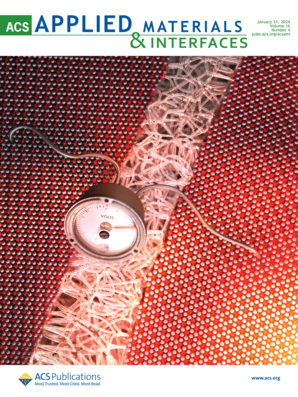Nanofibrillar Cellulose Hydrogels with Anionic Surface Modifications for Modulating Macrophage Phenotype in 3D Culture.
IF 8.3
2区 材料科学
Q1 MATERIALS SCIENCE, MULTIDISCIPLINARY
引用次数: 0
Abstract
Anti-inflammatory M2 macrophages are highly relevant in various physiological processes ranging from tissue regeneration to cancer progression. However, conventional two-dimensional (2D) in vitro cell cultures limit our understanding of macrophage phenotypes and how they can be modulated for immunotherapeutic approaches. Moreover, there is a growing demand for scalable, animal-free hydrogels to replace animal-derived materials in three-dimensional (3D) in vitro models. In this study, we explore hydrogels based on plant-derived nanofibrillar cellulose (NFC), also known as cellulose nanofibrils (CNFs) or microfibrillated cellulose (MFC), for generating 3D in vitro models of M2-like macrophages from human blood monocytes. Notably, flow cytometry analysis shows that cells cultured in 3D phosphorylated NFC hydrogels show enhanced expression of the M2 macrophage marker CD206 compared to cells cultured in other negatively charged hydrogels prepared from native NFC or NFCs with carboxylate or sulfate modifications. Furthermore, the upregulation of CD206 expression in 3D phosphorylated NFC is comparable to the induction of CD206 in interleukin 4 (IL-4)-differentiated M2a macrophages. In addition, the cells in the phosphorylated NFC hydrogel show a differential cytokine profile compared to 2D cultured cells, secreting similar levels of tumor necrosis factor α (TNF-α), but 2.6-fold higher amounts of IL-1β and 1.2-fold higher amounts of IL-10. The results suggest that the conversion of monocytes to M2-like macrophages can be controlled by the phosphorylation of NFC, a strategy which does not require the addition of polarization factors like growth factors and cytokines conventionally used to generate macrophages in vitro. The findings highlight the importance of surface chemistry in matrix-guided macrophage polarization, paving the way for xeno-free yet bioactive 3D macrophage culture scaffolds for immunological research.具有阴离子表面修饰的纳米纤维纤维素水凝胶在3D培养中调节巨噬细胞表型。
抗炎M2巨噬细胞在从组织再生到癌症进展的各种生理过程中高度相关。然而,传统的二维(2D)体外细胞培养限制了我们对巨噬细胞表型的理解,以及它们如何被免疫治疗方法调节。此外,在三维(3D)体外模型中,对可扩展的、不含动物的水凝胶的需求不断增长,以取代动物来源的材料。在这项研究中,我们探索了基于植物源性纳米纤维纤维素(NFC)的水凝胶,也称为纤维素纳米纤维(CNFs)或微纤化纤维素(MFC),用于从人血液单核细胞中生成m2样巨噬细胞的体外3D模型。值得注意的是,流式细胞术分析显示,与在天然NFC或羧酸盐或硫酸盐修饰的NFC制备的其他负电荷水凝胶中培养的细胞相比,在3D磷酸化的NFC水凝胶中培养的细胞显示M2巨噬细胞标志物CD206的表达增强。此外,CD206在3D磷酸化的NFC中的表达上调与CD206在白细胞介素4 (IL-4)分化的M2a巨噬细胞中的诱导相当。此外,与2D培养细胞相比,磷酸化NFC水凝胶中的细胞表现出不同的细胞因子谱,分泌相似水平的肿瘤坏死因子α (TNF-α),但IL-1β含量高2.6倍,IL-10含量高1.2倍。结果表明,单核细胞向m2样巨噬细胞的转化可以通过NFC的磷酸化来控制,这一策略不需要额外的极化因子,如生长因子和细胞因子,通常用于体外产生巨噬细胞。这些发现强调了表面化学在基质引导巨噬细胞极化中的重要性,为无异种但具有生物活性的3D巨噬细胞培养支架的免疫学研究铺平了道路。
本文章由计算机程序翻译,如有差异,请以英文原文为准。
求助全文
约1分钟内获得全文
求助全文
来源期刊

ACS Applied Materials & Interfaces
工程技术-材料科学:综合
CiteScore
16.00
自引率
6.30%
发文量
4978
审稿时长
1.8 months
期刊介绍:
ACS Applied Materials & Interfaces is a leading interdisciplinary journal that brings together chemists, engineers, physicists, and biologists to explore the development and utilization of newly-discovered materials and interfacial processes for specific applications. Our journal has experienced remarkable growth since its establishment in 2009, both in terms of the number of articles published and the impact of the research showcased. We are proud to foster a truly global community, with the majority of published articles originating from outside the United States, reflecting the rapid growth of applied research worldwide.
 求助内容:
求助内容: 应助结果提醒方式:
应助结果提醒方式:


